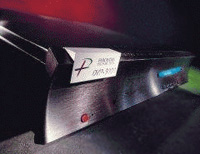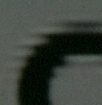Faroudja's Next Generation Line Multiplier
by Peter W. Simeon and Michel Hafner(10 September 1999)


When we read the specifications for the new DVP 3000, we were very excited as it promised to be a very flexible device. Coming from the company, who built line multipliers which were the reference until today, the picture quality is expected to be as good as technically possible.
The new digital video processor comes in the same design which was introduced with xx1 series. The user interface was changed and now all functions are selected through menus. Only five buttons are left (function +/-, value +/- and factory). Of course, it is a matter of preference whether you like menus or direct access buttons. However, for functions such as input select, direct access buttons are much more comfortable. We liked the old approach better. One problem with the old approach was that you could not select the input directly with the infrared remote control, which made it nearly impossible to program macro sequences into a programmable remote control. This is now possible because there are many new direct commands, which can be used with the included programmable infrared remote control.
The connectors on the back of the unit are more or less the same as on the VP 401, except that the inputs are now RCA instead of BNC. Altough RCA connectors are more common on home theatre products, BNCs are consired better because they fit better and there is no problem with the impedance of the connectors themselves. Above the video inputs, there is a covered expansion slot. The manual does however not say anything about its purpose.
To test the DVP 3000 digital video processor, we used a very high end system consisting of a Sony DVP-S7700 DVD player and a Barco 1209S 9 inch crt projector projecting onto a 2.4 meter wide Stuart srceen with a gain of 1.3. To compare the DVP 3000 with the VP 401U, we connected two Sony DVP-S7700 players to the component input of each video processor and then each output to a Kramer component video switcher. All cables used were Monster Cable Video Series 3.
We generally conduct tests by first aligning the system with the Video Essentials DVD. Then we look at the test patterns and finally we watch the "Montage of Images" sequence followed by some scenes of DVDs which we rate as reference in picture quality, such as The Fifth Element, Dark City, Starship Troopers or West Side Story.
As a first test we set up the DVP 3000 to work in quadruple mode, where we expected to see some improvements over the VP 401U or at least the same quality. We assumed that the factory settings are a good starting point for calibrating the system. Starting from these factory values we discovered that the signal levels are slightly different from the VP 401U in its default settings. After comparing contrast and brightness, we set both values on the DVP 3000 to 124 instead of 128 and left the VP 401U at 128, which was always our preferred setting to test equipment. The projector was then again calibrated with the Pluge and the SMPTE Color Bars test patterns. To setup the color saturation we used the blue filter, which was included with the Video Essentials DVD. As with the VP 401U we had to increase the color value to 177. (This is reasonable, and we also had to do this on other Faroudja line multipliers such as the VP 251. When comparing S-Video and component inputs from the same DVD player, both images look equal when the color of the component input is increased to 177 while leaving the color setting of the S-Video input at its 128 default. Tint is usally also left at 128). The detail function was set to 97 on VP 401U and to 7 on the DVP 3000U. These values provided good sharpness and resonably few ringing artifacts and were evaluated with the Overscan test pattern.
After stepping through the different test patterns we soon discovered some problems and after watching some more test patterns and some video sequences, it was clear that the DVP 3000U was inferior to the VP 401U in almost all respects. We have provided screen shots, made with a digital video camera, to make the problems visible on the web. The main problems were:
 |
The color balance problem was only visible in direct comparison, but we still thought it was odd because Faroudja is one of the very few companies how managed to get NTSC color decoding done correctly. Proper color temperature is a very important prerequisit for accurate color reproduction. After further testing we also discovered that the reddish tint is dependent on the gray level. This is very noticable in the Gray Bars test pattern.
Occasionally we saw some video noise in various test patterns like in the green bar of the SMPTE Color Bars test patterns or in a full field gray pattern. Since the noise level was not always the same, we further tried to find out what's causing it. After playing a bit around with various settings, we found out that the detail control is responsible for the video noise. Only the settings 0 and 7 provided noise free picture. Setting 0 is, of course, totally useless because then the picture is way too soft. Setting the detail to 7 was optimal for sharpness as well, so we were lucky. However, we also tried to reduce detail slightly to avoid the artifact problem, but since setting detail to 5 produced more video noise this was not usable after all. Using the DVP 3000U with different projectors and DVD players didn't help. We always saw some kind of noise. Interestingly the kind of noise/interference was different everytime we changed something. Sometimes it was just noise and sometimes we saw interference lines. The increased noise level was also noticeable while watching scenes from "The Fifth Element" DVD.
Watching the "Montage of Image" sequence, which consists a various scenes shot on video and on film revealed that the new video interpolation algorithm is sometimes better (when fast movements were present) and sometimes worse (when pictures were mostly still). It looks like the new algorithm switches more between modes and therefore introduces a certain unsteadiness. The film mode behaved like it used to be on the older models and there was nothing to complain about it. After all, as far as we know, it is still the same algorithm.
After these initial tests we wanted to test other output modes to
see how the new Faroudja performed with the new features. We watched
several scenes on both the Barco 1209S as well as on a 7 inch Barco 701/MM.
The 720P mode is very good for the Barco 701/MM. Watching non anamorphic
NTSC stuff is much better, because you don't have visible scan lines
anymore. Sharpness is about the same as on the VP 251. For some
strange reason the artifacts, which were very annoying, are less
intrusive on the 7 inch projector at 720P, but very much visible in
line doubling mode on the same projector.
While watching parts of Starship Troopers in different
output resolutions we suspected that full picture quality could
only be achieved by using doubling, 720P for NTSC and quadrupling.
Especially the title credits sequence was less good in 1080P than
in quadrupling mode. The reason for this is that double, triple or
quadruple an image is mathematically much easier than scale it to any
other resolution. We then made further tests and could confirm that all
other modes introduce some scaling artifacts. It seems that Faroudja does not
use the best scaling algorithms. When watching PAL signals in 720P
from Satellite using a high end Chaparral Monrerey 140 analogue receiver
connected to 1.5 meter dish to receive the Astra satellites (we
watched "Star Trek: Voyager" on Sky One), we could see lots
of these interpolation artifacts. There were less artifacts in higher
resolutions, but they were still visible.
This means that to achieve optimal picture quality you need to use the DVP 3000U like a doubler or a quadrupler:
| PAL | 1152P or 576P |
| NTSC | 960P, 720P or 480P |
When the goal is to have the best possible picture, you can forget about 800 x 600, 1024 x 768 and 1080P and also about the aspect ratio control, because the DVP 3000U also needs to interpolate for this feature. You have to use the projector in anamorphic mode for anamorphic software.
Unfortunately we discovered some more problems while watching PAL television. All Faroudja line multipliers so far had a bug which caused them to occasionally switch to the wrong (film or video) mode during video material in PAL. The DVP 3000P is much worse in that regard and after zapping though a lot of channels we had to switch it off and on again to produce a watchable picture. The features to disable either film or video mode do not work at all (in PAL at least). There were no settings which worked without falling into a wrong mode sometimes.
Conclusion
The DVP 3000 has some interesting concepts and multiple output resolutions
combined with aspect ratio control is certainly the way to go. If you use
a fixed resolution display device such as an LCD or DLP projector, the new
Faroudja line multiplier has exactly the functionality which was lacking
in their earlier product line. On the other hand, if you have a CRT projecter,
the VP 251U or the VP 401U are still the better choice.
Altough the DVP 3000U has some advantages,
we can not fully recommend it at the current time. Problems like the
artifacts problem or the color balance problems are not that severe
when watching movies, but we think that compared to the earlier models the
performance is simply not good enough. For watching PAL
it is not suitable at all and the new video interpolation algorithm as
well as the new Scan-Lock feature to increase sharpness are hardly
worth an upgrade considering the other problems. We hope that Faroudja will
addresses most of the problems outline above. Until then keep your old
model or try to buy one as long as they are still around. The old models
produce a more stable, more natural and more filmlike picture. After all,
this is exacly what a line multiplier is supposed to do.
Advantages of the VP 3000:
Disadvantages of the VP 3000:
The processing artifacts have been eliminated by new factory settings. Older models can be fixed by entering new default settings in service mode.
The color processing is still not as good as on the VP 401 and in some extreme cases even color banding can occur. This effect is less visible using the S-Video input. Some people report that this problem has become less severe after upgrading the VP 3000 to a VP 5000, which is basically the same processor with additonal HDTV processing capabilities.
Having used a VP 3000 for a long time now, I have to say it's a very good processor indeed. Not many other products come even close to its performance. The DCDi algorithm works very well with many types of images and is a unique feature only Faroudja has offered until now. But some of the above mentioned problems can still be seen in everyday use and are not acceptable at this price range, in my opinion. In that regard the VP 401 was a better product.